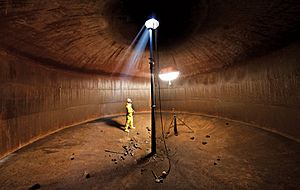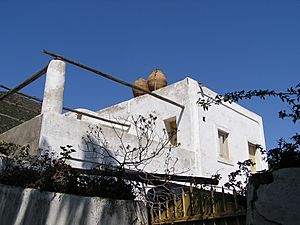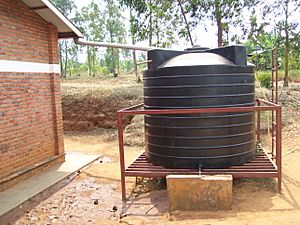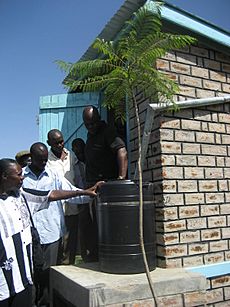Rainwater harvesting facts for kids
Rainwater harvesting (often called RWH) is a way to collect and store rain instead of letting it run away. Imagine catching rain from a roof and sending it into a big tank, a deep pit, or even underground to refill natural water stores. You can also collect dew and fog using special nets.
Rainwater harvesting is different from collecting stormwater. Stormwater usually comes from streets and other large areas. Rainwater harvesting focuses on collecting water from roofs and smaller surfaces. This collected water can be used for many things. You can water gardens, give it to farm animals, or use it for farming. With the right cleaning, it can even be used inside homes for drinking or heating. Sometimes, the water is stored for a long time or used to refill underground water supplies.
This method of getting water for homes is very old. People in South Asia and other places have used it for thousands of years. Rainwater harvesting systems can be built for single homes, whole neighborhoods, or even large places like schools and hospitals.
Contents
How is Rainwater Harvesting Used?






For Homes and Daily Life
Collecting rainwater from rooftops is great for many home uses. It can provide water for drinking, washing, and other daily needs. It also helps water farm animals and small gardens. Plus, it can help refill underground water sources.
For Farming and Gardens
In cities, collecting rainwater helps reduce flooding. It also lowers the amount of water that runs off surfaces. Green rooftops that collect rain can even make buildings cooler. They can lower building temperatures by more than 1 degree Celsius.
Using rainwater harvesting with city farming helps meet global goals. These goals include having cleaner cities, better health, and enough food and water for everyone. The technology is ready, but it needs to be improved for city use. This will help us use water more wisely.
Kenya already uses collected rainwater for toilets, laundry, and watering plants. Australia also uses harvested rainwater for cooking and drinking. Studies in India show that collecting rainwater is best for small farms. It helps farmers earn money from their crops. Any extra water can go back into the ground.
In the Caribbean, collecting rainwater helps farmers a lot. It reduces the risk of losing crops due to dry soil or not enough water. It also lowers the risk of floods and soil washing away during heavy rains. Small farmers, especially those on hills, benefit most. They can catch runoff water and stop soil erosion.
Many dry countries use rainwater harvesting. It is a cheap and reliable way to get clean water. Farmers build small ridges in the soil to trap rainwater. This stops water from running down hills. Even with little rain, enough water is collected for crops to grow. Water can be collected from roofs. Large ponds can also hold lots of rainwater. This ensures there is enough water for crops even on dry days.
For Businesses and Factories
Frankfurt Airport in Germany has a huge rainwater harvesting system. This system saves about 1 million cubic meters of water each year. It cost about $63,000 in 1993. The system collects water from the roofs of the airport's new terminal. This roof area is very large, about 26,800 square meters. The water is stored in six tanks in the airport's basement. Each tank can hold 100 cubic meters of water. This water is mainly used for flushing toilets, watering plants, and cleaning the air conditioning system.
The Velodrome at the Olympic Park, London also uses rainwater harvesting. This was done to make the building more sustainable. It was expected to reduce the park's need for clean drinking water by 73%. However, it was found that recycling dirty water (blackwater) was a more cost-effective way to be sustainable.
How Rainwater Harvesting Works
Traditionally, systems that manage stormwater only had one purpose. But now, smart control systems can make them do two jobs. They can collect rainwater while still managing stormwater. For example, the EPA headquarters uses this. They empty stored water before storms. This reduces water flow during wet weather. It also makes sure water is available for later use. This helps improve water quality and reduces overflow during heavy rains.
Sometimes, small dams called check dams are built across streams. These dams help surface water soak into the ground. This soaking can be made much faster by loosening the soil. This helps refill local underground water sources quickly. Then, this water can be used during dry seasons.
Setting Up a System
Rainwater harvesting systems can be simple or very complex. Some can be set up with basic skills. Others need advanced planning and installation. A basic system is like a plumbing job. All the pipes from a building's roof are connected to an underground tank. This tank stores the water.
These systems often have common parts. They include filters to clean the water first. They also have drains or gutters to direct the water. There are storage containers, of course. If the system needs water pressure, it will have pumps. It might also have cleaning devices like UV lights or chlorine systems.
Systems should be big enough to meet water needs during dry times. The area that collects rain, like a roof, must be large enough to get enough water. The storage tank should also be big enough to hold all the collected water. For simple systems, many low-tech ways are used. These include rooftop systems or collecting surface water. You can also pump rainwater that has already soaked into the ground or is in reservoirs. Then, you store it in tanks.
Using Forests to Harvest Rainwater
You can harvest rainwater by growing forests that are flooded with freshwater. This can be done without losing money from the land. The main goal is to use local rainwater to meet water needs all year. This avoids needing to spend a lot of money on big projects. It helps provide clean water for homes, businesses, and farms.
Using Solar Panels to Harvest Rainwater
Finding good quality water near cities is becoming harder and more expensive. Besides solar and wind energy, rainwater is a major natural resource. Huge areas are now covered by solar panels every year. These solar panels can also collect most of the rainwater that falls on them. This water can be cleaned easily. Simple filters and cleaning methods can make it safe to drink. This is because rainwater has very little salt.
Collecting rainwater for bottled drinking water can make solar power plants more profitable. This is true even in rainy or cloudy areas. This extra income comes from making valuable drinking water. Recently, collecting rainwater in already dug wells has been very good. It helps bring up the underground water level in India.
Other New Ideas

Instead of using a roof to collect rain, the RainSaucer collects rain directly from the sky. It looks like an upside-down umbrella. This reduces the chance of the water getting dirty. This makes the RainSaucer useful for getting drinking water in developing countries. It can also be used for gardening and small farms.
Another invention from the Netherlands is called the Groasis Waterboxx. It helps grow trees using collected dew and rainwater.
Why Rainwater Harvesting is Good
Rainwater harvesting gives you your own water supply. This is helpful when there are water limits in your area. In richer countries, it often adds to the main water supply. It provides water during dry times. It can also help stop flooding in low areas. It reduces the need for water from wells, which helps keep underground water levels healthy.
Rainwater harvesting makes more water available during dry seasons. It helps fill up dry wells. Surface water is easily available for many uses. This means less reliance on underground water. It also improves the quality of ground water by making it less salty. It does not cause pollution and is good for the environment. It is also affordable and easy to use. Rainwater is mostly free of salt, so it can be made safe to drink.
Using rainwater harvesting in city water systems has many benefits. It reduces the need for clean water in homes. It also means less stormwater goes into sewer systems. This helps reduce pollution in rivers and lakes.
Many studies have looked at how good rainwater harvesting is for the environment and how much money it can save.
Your Own Water Supply
Rainwater harvesting gives you an independent water supply. This is very important in places where clean water is expensive or hard to find. In developed countries, it often adds to the main water supply. But it can also lower a household's water bills or overall water use.
Rainwater can be safe to drink if you clean it properly. Boiling water helps kill germs. Adding a "first flush" diverter is also common. This device sends away the first bit of rain. This first rain often has the most dirt. Better water quality can also be achieved by taking water from the top of the tank, not the bottom. Using a series of tanks and taking water from the last one also helps. Filtering the water before it enters the tank is a good way to keep the system clean.
Helps During Dry Times
When there is a drought, you can use rainwater collected in earlier months. If rain is rare and hard to predict, a rainwater harvesting system is very important. It helps catch the rain when it does fall. Many dry countries use rainwater harvesting. It is a cheap and reliable way to get clean water. Farmers build ridges in the soil to trap rainwater. This stops water from running down hills. Even with little rain, enough water is collected for crops to grow. Water can be collected from roofs, and tanks can hold large amounts of rainwater.
Also, rainwater harvesting means less water is taken from wells. This helps keep underground water levels healthy instead of running out.
Saves Money
Rainwater harvesting systems can provide water to poor areas. But the cost of setting them up can be high, depending on the technology. Governments and aid groups can help poor communities. They can provide materials and teach people how to build and maintain these systems.
Many studies show that rainwater harvesting is a good solution for water shortages. It is affordable and good for the environment. Building new, large water systems like dams can harm local nature. They can also create social problems and have limited uses, especially in developing countries.
On the other hand, rainwater harvesting systems give local communities a lasting water source. They also offer other benefits. These include protection from floods and control of water runoff. This is true even in poor areas. Systems that local people can install and maintain themselves are better for the environment. They are also more likely to help people for a longer time. So, systems that can be managed by local people are more likely to be used by many.
Simple, local technologies can lower the cost of rainwater harvesting. These technologies are good for rural areas because they need less material to build. They can provide a reliable water source to help grow more crops. Tanks above ground can collect water for home use. However, these can be too expensive for people in poverty.
What Are the Challenges?
Rainwater harvesting is widely used in countries with droughts. Many studies have found ways to choose the best places to collect rainwater. Some research has identified good spots for building dams. It has also created computer models to find suitable sites. These models look at things like slope, how much water runs off, land use, and soil quality.
In dry cities like those in the Middle East, harvested water can be very little during dry periods. Rainwater harvesting is helpful for developing areas. It collects water for farming and home use. But the collected water must be cleaned well to be safe for drinking.
Water Quality
Rainwater needs to be checked carefully. Then, it should be used in a way that is safe. For example, in China's Gansu province, people boil collected rainwater in solar cookers before drinking it. These simple methods are cheap ways to clean stored rainwater for drinking.
Rainwater itself is usually clean. It is often better than water from underground or from rivers. But the way it is collected and stored can make it dirty. Rainwater from roofs can contain animal waste, moss, dust, pollution from cities, and even pesticides. It can also have salts from the sea and dissolved gases. The amount of these dirty things is much lower if you send away the first bit of rain that runs off. This "first flush" often has the most dirt.
You can also get cleaner water by taking it from the top of the tank, not the bottom. Using several tanks in a row and taking water from the last one also helps. Filtering the water before it enters the tank is a common way to keep the system healthy. It makes sure the water going into the tank is free of large dirt particles.
A research institute in India has developed a way to collect rainwater and clean it with solar energy for homes in rural areas.
Ideally, a water system should match the water quality to its use. But in most developed countries, high-quality drinking water is used for everything. This wastes money and energy. It also harms the environment more than needed. Providing rainwater that has been simply filtered for non-drinking uses is a good idea. This includes water for flushing toilets, watering gardens, and doing laundry. This can be a big part of a sustainable water plan.
Rainwater tanks can also become homes for mosquitoes that carry diseases. So, you must make sure mosquitoes cannot get into the tank to lay eggs. You can also add fish that eat larvae to the tank or treat it with chemicals.
Research and Studies
The Water Research Commission in South Africa has supported research on rainwater harvesting. Studies in dry, semi-dry, and wet areas show that certain methods work well. These include mulching, digging pits, making ridges, and changing how water runs onto plots. These methods are good for small-scale farming.
A technique called hydrofracturing has been used to improve water wells. Between 1990 and 1992, 170 wells were improved using this method.
Examples from Different Countries
Canada
Rainwater harvesting is becoming more popular in Canada. People are using it for outdoor watering, flushing toilets, and even for drinking water after treatment. Many provinces and cities have rules or programs to encourage it.
India
While collecting rainwater in cities has become popular recently, people in rural India have been doing it for a very long time.
United Kingdom
In the United Kingdom, rainwater harvesting is mainly used for non-drinking purposes. This includes flushing toilets, watering gardens, and washing clothes. It helps save treated drinking water.
United States
In the United States, rainwater harvesting is used for many things. These include watering gardens, flushing toilets, and even for drinking water in some areas. Many states and cities have rules and incentives to encourage it.
Other Countries

- Uganda: Rainwater harvesting has helped homes and communities in Uganda get water for many years. Keeping the systems working is a challenge. Many systems have failed because they were not maintained well. Research also shows that not everyone in Uganda knows about rainwater harvesting or how to get help to set it up.
- Thailand: About 40% of people in rural Thailand rely on rainwater harvesting. The government strongly promoted it in the 1980s. When government funding stopped in the 1990s, private companies stepped in. They provided millions of tanks to homes. Many of these tanks are still used today. This is one of the largest examples of people getting their own water supply in the world.
- Bermuda: The law in Bermuda says that all new buildings must include rainwater harvesting. It must be enough for the people living there.
- New Zealand: New Zealand gets a lot of rain in the west and south. Rainwater harvesting is common in many rural areas. Water from roofs is collected by gutters and sent into covered tanks. Most local councils encourage this.
- Sri Lanka: In Sri Lanka, rainwater harvesting has been a popular way to get water for farming and drinking in rural homes. A law was passed in 2007 to promote it. The Lanka Rainwater Harvesting Forum leads this effort in Sri Lanka.
History of Rainwater Harvesting
The idea of building and using cisterns to store rainwater goes back a very long time. In the Neolithic Age, which was thousands of years ago, people built waterproof cisterns in the floors of their homes. This happened in villages in the Levant, a region in Southwest Asia. By 4000 BC, cisterns were key to managing water for farming in dry lands.
Many old cisterns have been found in Jerusalem and across what is now Israel/Palestine. At a site believed to be the ancient city of Ai, a huge cistern was found. It dates back to around 2500 BC. It could hold almost 1,700 cubic meters of water. It was carved from solid rock, lined with large stones, and sealed with clay to prevent leaks.
The Greek island of Crete is also known for using large cisterns. These were for collecting and storing rainwater during the Minoan civilization (2,600 BC–1,100 BC). Four large cisterns have been found. One at Myrtos-Pyrgos could hold over 80 cubic meters of water and dates back to 1700 BC.
Around 300 BC, farming communities in Balochistan (now in Pakistan, Afghanistan, and Iran) and Kutch, India, used rainwater harvesting for farming and other needs. Chola kings in India also collected rainwater. Water from the Brihadeeswarar temple was collected in a tank. Later, during the Chola period, the Vīrānam tank was built (1011 to 1037 AD). This tank was 16 kilometers long and held a huge amount of water. It was used for drinking and farming.
Rainwater harvesting was also common in the Roman Empire. While Roman aqueducts are famous, Roman cisterns were also widely used. Their construction grew as the Empire expanded. For example, in Pompeii, collecting water from rooftops was common before an aqueduct was built in the 1st century BC. This continued with the Byzantine Empire, as seen with the Basilica Cistern in Istanbul.
For centuries, the city of Venice depended on rainwater harvesting. The lagoon around Venice has salty water, which is not good for drinking. The people of Venice created a system of collecting rainwater. It used man-made, insulated wells. Water soaked down through special stone flooring. It was filtered by a layer of sand, then collected at the bottom of the well. Later, Venice started to bring water by boat from rivers on the mainland. But the wells were still used, especially during wars when mainland water could be cut off.
Images for kids
See also
 In Spanish: Sistema de captación de agua de lluvias para niños
In Spanish: Sistema de captación de agua de lluvias para niños
- Air well (condenser)
- Atmospheric water generator
- Blue roof
- Catchwater
- Desalination
- Detention basin
- Dew pond
- Hydropower
- Peak water
- Rain power
- Rainwater harvesting in the Sahel
- Retention basin
- Tank cascade system
- Water conservation






